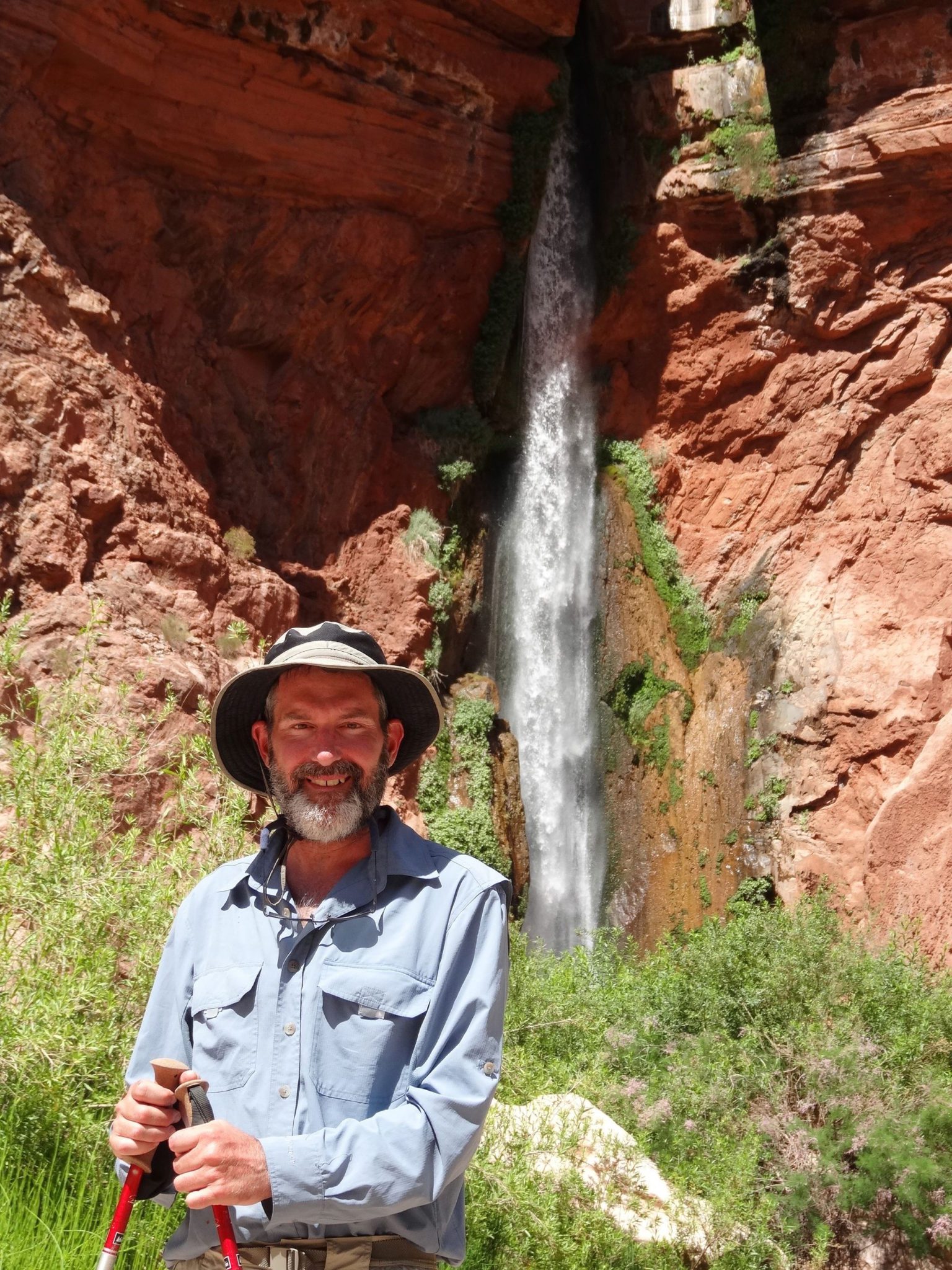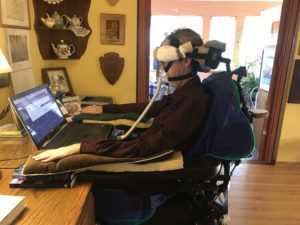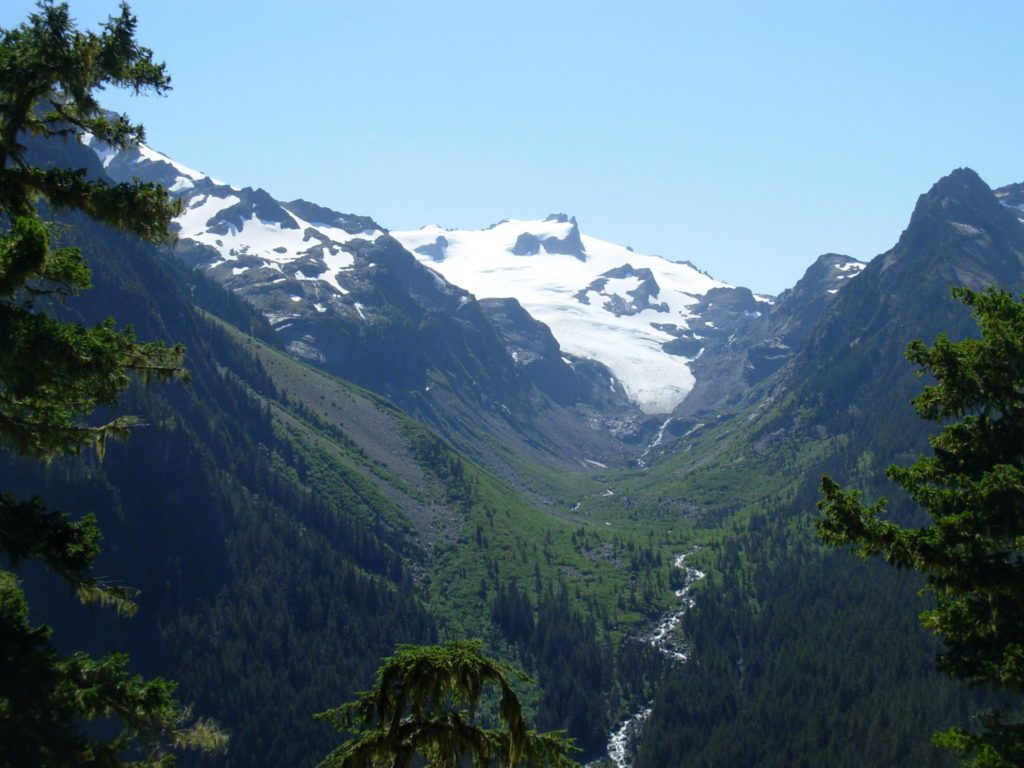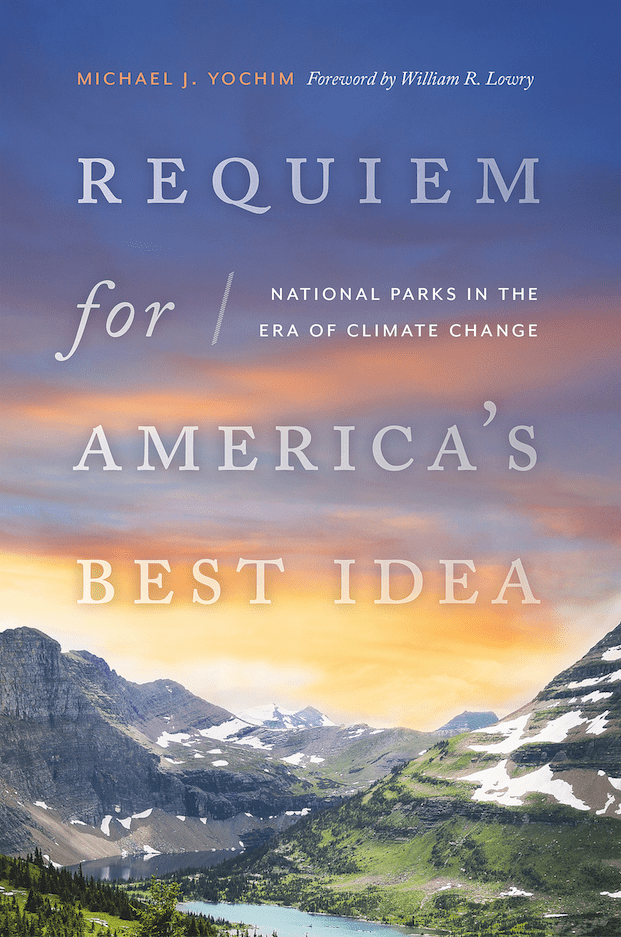
by Michael J. Yochim (1966-2020)

Mike Yochim working at his desk. Photo by James J. Yochim.
Mike Yochim refused to let ALS, perhaps the deadliest disease known to humans, stop him from writing this book about the impacts of climate change on the national parks. He refused even though he knew he had only months to live. He refused even though the disease was ravaging his body to the point where the only thing he could control were his eyes. He refused even though writing was exhausting, using an eye-tracking machine to pick out letters and then make sentences. It would take hours to write a single paragraph. And he literally died doing it. Why? First, because loved the national parks. He had spent his adult life in them, working, hiking, embracing the wilderness. He loved what he had done in them and what they had done for him. Second, he knew that the parks are in trouble, their very essence challenged by climate change and the fires, drought, disease and extreme temperatures that come with it. Third, Mike understood that his terminal illness enabled him to appreciate the challenges facing the parks as no one else could. He knew that even though his fate was determined, that of the parks is not. We can still change to save these wonderful places. But we must act. And if Mike could do what he did even while dying, how can we not try? –William R. Lowry
Hiking down from Blue Glacier in Olympic National Park, I wondered what the viewpoints would look like a decade or two later, given the warmth that had me in shorts and a t-shirt at just mid-morning. How far would the glacier recede? Will the people who make the trek to that place know the difference between what they see and what was? What about those who make the trip thirty or forty years from now, when the glacier is significantly smaller? At what point will the view from the upper overlook no longer inspire us, if ever? The mountain won’t disappear, but will it be as jaw-dropping without Blue Glacier and its impressive icefield? And if I, an employee of the very agency charged with protecting the parks, hadn’t known about the glacier beforehand, how many future hikers will recognize the difference between the naked mountain they see and the formerly ice-clad mountain fastness? In other words, if some beauty will survive the melt-off, why worry about global warming, especially since many of us (perhaps most?) won’t know the difference?

White Glacier and Glacier Creek, Olympic National Park. Photo from Michael J. Yochim photo collection.
Such questions are difficult to answer effectively, in part because we don’t know what the future will bring. But I think we know some of the answers: beauty reduced is beauty diminished, for without its glaciers, the mountains in Olympic will no longer be unique and will resemble dozens of other mountain ranges in the West. Beauty reduced also violates the code we have as caretakers of the earth, for it means we’re not passing the planet down to our children in better shape than we received it from our parents. It violates the golden rule, too, to do unto others as we would have them do to us, for it means we are damaging communal properties. It disrespects our fellow creatures, because glaciers provide year-round cold water to the streams and rivers that sustain an abundance of fish and birds and mammals and amphibians. Finally, it suggests an arrogance that is at odds with the attitude of humility and restraint one should have in the presence of anything powerful and complex, a heedless disregard for the consequences of our actions, known and unknown, direct and indirect, short-term and long-term. Besides being a view out of place, then, the view of Blue Glacier was also a scene out of time, knowing that the glacier’s years are numbered. It was like looking at the last of an endangered species, thrilling to see the creature in the flesh, but sad to know that even if we directed all our personal efforts into saving the species, the animal would probably still go extinct. The view into the heart of Olympic, then, was simultaneously thrilling and disquieting.
As the planet warms more, some plants and animals may come to find their habitat too hot or dry, forcing them to migrate to find suitable conditions for their growth. If that is impossible for them, they may die out, possibly everywhere. Our crops may fail, victims of the same changes. Melting glaciers and icecaps in Greenland and Antarctica will raise ocean levels and flood many of the world’s most populous cities; already, the Atlantic Ocean on the eastern seaboard has risen five or six inches, producing recurring minor flooding during especially high tides. Also, warming the climate energizes it, producing more powerful and destructive storms, like the 2017 hurricanes in the Gulf of Mexico. The list of possible effects, present-day and predicted, is long indeed, so I focus on the national parks.
And that picture is disturbing. Warming temperature, fires, and tree diseases are ravaging Olympic, Glacier, Yellowstone and Yosemite. Drought is severely impacting the Grand Canyon. The Everglades face inundation from unchecked sea level rise. The forests of the Great Smoky Mountains are increasingly at risk of larger and more frequent forest fires. In the Alaskan parks, as the permafrost of the tundra melts, frozen carbon escapes into the atmosphere via several different pathways. Scientists are just beginning to understand those mechanisms, so they have not been included in the climate change models. Estimates are that only five to 15 percent of the frozen carbon will escape to the atmosphere, which may not sound like much. But when you multiply that number by the vast amount of tundra in Alaska, Canada, and Siberia, it’s equivalent to the total amount of carbon we have in the atmosphere. So, this is quite worrisome.
The perils for humanity are many, serious, and destabilizing, including excessive heat, crippling drought, food and water insecurity, warfare over these problems, coastal flooding and refugee displacement, and many other significant problems. It is the height of irresponsibility to deflect attention from this most urgent existential threat.
 Yet, today, the society that was responsible for setting aside these wonderful places for future generations is turning its back on the future. The human contribution to climate change is still a matter of debate among the Republican party and others who don’t believe scientific findings that conflict with their way of seeing the world. As well they might debate whether smoking causes lung disease or whether the earth is round, for the research proving the human role in warming the planet is as solid and conclusive. In forcing a debate where there is nothing debatable and thereby delaying action to stave off further warming, Republicans like Donald Trump have led the way toward a climate never seen before in the human experience, and at a rate that has also never been seen in our experience. The perils for humanity are many, serious, and destabilizing, including excessive heat, crippling drought, food and water insecurity, warfare over these problems, coastal flooding and refugee displacement, and many other significant problems. It is the height of irresponsibility to deflect attention from this most urgent existential threat.
Yet, today, the society that was responsible for setting aside these wonderful places for future generations is turning its back on the future. The human contribution to climate change is still a matter of debate among the Republican party and others who don’t believe scientific findings that conflict with their way of seeing the world. As well they might debate whether smoking causes lung disease or whether the earth is round, for the research proving the human role in warming the planet is as solid and conclusive. In forcing a debate where there is nothing debatable and thereby delaying action to stave off further warming, Republicans like Donald Trump have led the way toward a climate never seen before in the human experience, and at a rate that has also never been seen in our experience. The perils for humanity are many, serious, and destabilizing, including excessive heat, crippling drought, food and water insecurity, warfare over these problems, coastal flooding and refugee displacement, and many other significant problems. It is the height of irresponsibility to deflect attention from this most urgent existential threat.
My own experience with ALS enhances my sensitivity to these potential changes. Just as wild places are being affected by climate change, there are invalids everywhere being affected by debilitating illness. Close to 40 percent of us will be diagnosed with cancer in his or her lifetime, and 22 percent of us will die of it. Heart disease, the most common affliction in America today, kills one in three of us. Every one of the millions of us who have a life-threatening disease has a story to tell of our experience with the illness, of its onset, of our day-to-day struggles to deal with it and perhaps overcome it. These are stories of the human experience, stories that evoke emotion and community in those who read or listen to them. They inspire and motivate us, giving us strength to face our own challenges and adversities.
Even if we can’t visit wild places, even if we have never been to the parks, even if we don’t have pictures of the wilderness areas, wild places inspire, give hope, and confer peace of mind.
Radical change links the parks, threatened by global warming, to the human experience, threatened by terminal disease, but there is something far more powerful joining the two. It’s the power of inspiration that wild places possess, merely by virtue of their existence. This attribute of parks and wilderness areas has long been known; indeed, it’s one of the reasons they were established in the first place. Some of the national parks were, in fact, used by the military for this express purpose during World War II. But, it bears repeating, in this era of government hostility to environmental causes, that those of us facing life-threatening illness need wild places for respite, inspiration, and imagination. Even if we can’t visit wild places, even if we have never been to the parks, even if we don’t have pictures of the wilderness areas, wild places inspire, give hope, and confer peace of mind. Just knowing they exist brings calm, the knowledge that somewhere there are beautiful places where the shackles of disease do not bind, where we can be free to roam and explore. They provide grist for the imagination, motivation to hope, and food for the soul. In a word, they provide resilience.
In sum, climate change is to the body politic as ALS is to those who suffer its effects, a growing threat to the parks and to the inspiration we draw from them.
If we don’t curtail our carbon emissions soon—and radically curb them—my experience may well become the universal experience. As the glaciers melt, forests burn, and wildlife move or die out across the West, all in the face of climate change, our collective memories of the unimpaired national parks will gradually fade, much like my increasingly distant recollections. And much like my inability to travel to the parks, we’ll be increasingly limited in when we can visit parks, due to the growing prevalence of fire, smoke, and other hazards. This projection of the future visitor experience, if you will, also extends to the landscape we will see; just as I look out on the altered landscape of Missouri, future visitors to the parks will see landscapes that have been significantly altered. However, just as there are some pockets of naturally functioning lands in Missouri, the parks will hold onto patches of naturally functioning forests and other vegetation types. “Naturally functioning” may be illusory, with no landscape completely immune to global warming, but some of these pockets will at least display nature’s forces equal to, or exceeding, the hand of humanity both contemporary and prehistoric. In this and other ways, then, the parks will probably always inspire, but not as readily as they do now. Also, as the climate warms further, it will probably become increasingly difficult to find inspiration in them, with their resource impairments more and more obvious to all. In sum, climate change is to the body politic as ALS is to those who suffer its effects, a growing threat to the parks and to the inspiration we draw from them.
What can be done to reduce the impact of climate change? If we get serious about reducing our emissions now, impacts could be cut in half. Some people are taking actions. Many nations have aggressive climate change policies. Even without national leadership in the U.S., dozens of states and hundreds of cities have endorsed the goals of the Paris Treaty. In the national parks, managers are pursuing efforts in accordance with the Climate Smart program. Many companies and individuals are also taking steps to reduce their carbon footprint. But, without responsible leadership from national policy makers, these efforts will not be enough.
Michael J. Yochim was a former national park ranger, having worked more than twenty years in Yellowstone, four and a half years in Yosemite, and seasonal assignments in Sequoia and Grand Canyon national parks. He is also the author of Essential Yellowstone: A Landscape of Memory and Wonder and Protecting Yellowstone: Science and the Politics of National Park Management.
Excerpted from Requiem for America’s Best Idea by Michael J. Yochim. Copyright © 2022. Available from High Road Books, an imprint of University of New Mexico Press.
